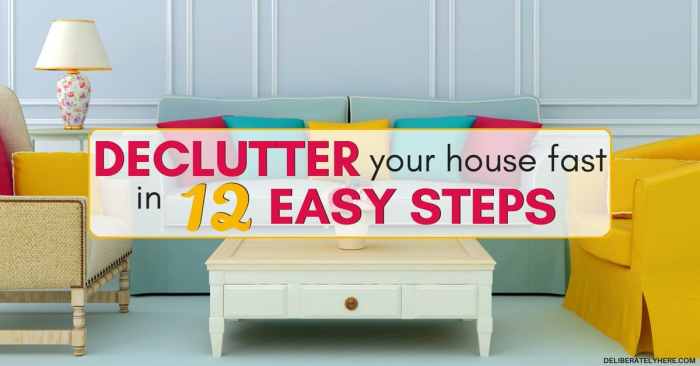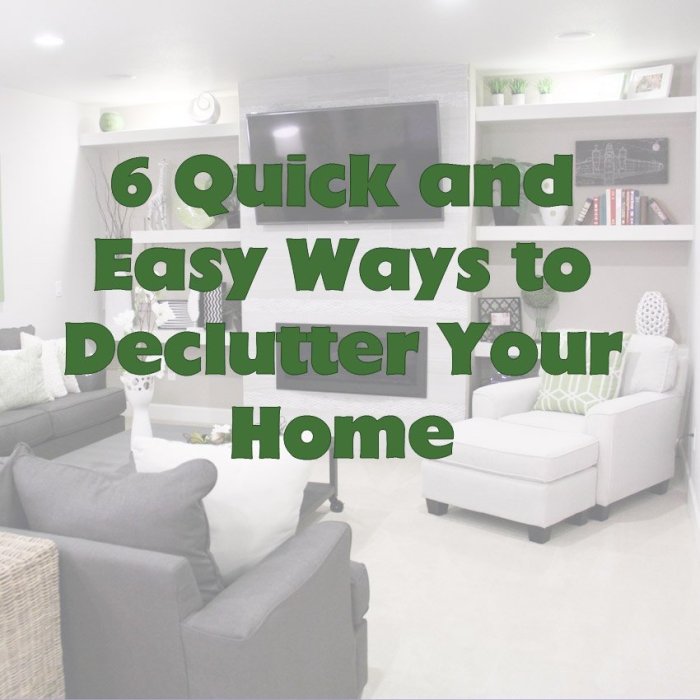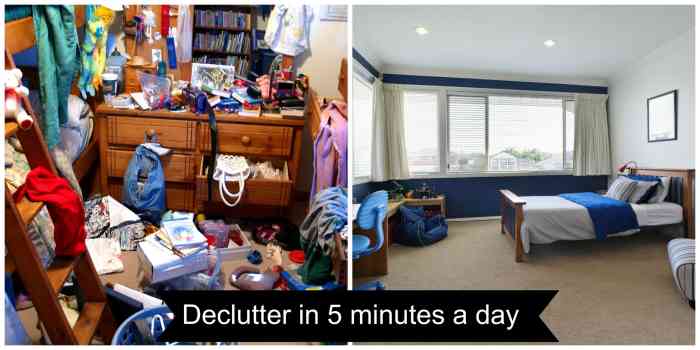Embark on a journey to transform your living space with How to Declutter Your Home in 5 Easy Steps. Discover practical tips and strategies to create a harmonious and organized home environment.
Learn how to prepare, sort, and sustainably declutter your home for a lasting impact on your living space.
Preparation for Decluttering

Before diving into the decluttering process, it is crucial to prepare adequately to ensure a smooth and efficient experience. Proper preparation can help you stay organized, focused, and motivated throughout the decluttering journey. Here is a checklist of essential items needed for decluttering and a detailed guide on how to create a decluttering plan for your home.
Checklist of Essential Items for Decluttering
- Large boxes or bins for sorting items into categories such as keep, donate, sell, or discard.
- Trash bags for disposing of items that are no longer needed.
- Labeling supplies to clearly mark the sorted items for easy identification.
- Cleaning supplies to wipe down surfaces and organize spaces as you declutter.
- A timer or schedule to allocate specific time slots for decluttering tasks.
- A donation box or bag to collect items that can be given away to charity.
Creating a Decluttering Plan for Your Home
Before you start decluttering, take some time to assess your space and create a plan to tackle the clutter effectively.
- Identify target areas: Determine which rooms or areas in your home need the most decluttering attention.
- Set goals: Establish specific, achievable goals for each decluttering session to stay motivated.
- Break it down: Divide the decluttering process into smaller tasks or sections to prevent overwhelm.
- Allocate time: Dedicate specific time slots in your schedule for decluttering sessions to make steady progress.
- Stay focused: Eliminate distractions during decluttering sessions to maximize productivity and efficiency.
- Celebrate progress: Acknowledge and celebrate your decluttering achievements to stay positive and motivated.
Sorting and Categorizing Items
When decluttering your home, sorting and categorizing items can significantly help streamline the process and make decisions easier. By grouping similar items together, you can assess the quantity of each category and determine what to keep, donate, or discard more effectively.
Benefits of Sorting Items into Categories
- Creates a clear visual of the items you have, making it easier to make decisions.
- Helps identify duplicates or unnecessary items that can be eliminated.
- Allows you to prioritize what items are most important to keep based on usage or sentimental value.
Tips for Deciding What to Keep, Donate, or Discard
- Ask yourself if you have used the item in the past year. If not, consider letting it go.
- Consider if the item holds sentimental value and if it aligns with your current lifestyle.
- Check for duplicates and keep only the ones that serve a purpose or bring you joy.
Strategies for Organizing Items Efficiently
- Use clear bins or containers to store items within each category to keep them organized.
- Label containers to easily identify what is inside and avoid confusion.
- Create designated spaces for each category to maintain order and prevent clutter from accumulating again.
Implementing Sustainable Decluttering Practices

When it comes to decluttering your home, it’s essential to consider sustainable practices that not only benefit your living space but also the environment. Sustainable decluttering involves making conscious choices to reduce waste and minimize the impact on the planet.
Repurposing and Recycling Items
Instead of simply throwing away items you no longer need, consider ways to repurpose or recycle them. For example, old clothing can be turned into cleaning rags or donated to thrift stores. Electronic devices can be recycled at designated facilities to prevent harmful chemicals from entering the environment.
- Donate gently used items to local charities or shelters.
- Host a garage sale to give unwanted items a second life.
- Recycle glass, plastic, paper, and metal materials whenever possible.
Maintaining a Clutter-Free Home
Once you’ve decluttered your home, it’s important to establish habits that will help you maintain a clutter-free environment in the long term. This not only keeps your space organized but also prevents unnecessary waste from accumulating.
- Designate a place for everything and make sure items are returned to their proper location after use.
- Regularly assess your belongings and declutter on a seasonal basis to prevent accumulation.
- Avoid impulse purchases and consider the environmental impact of new items before bringing them into your home.
Ending Remarks

Take charge of your living space today by following these simple yet effective decluttering steps. Say goodbye to clutter and hello to a more peaceful and organized home.